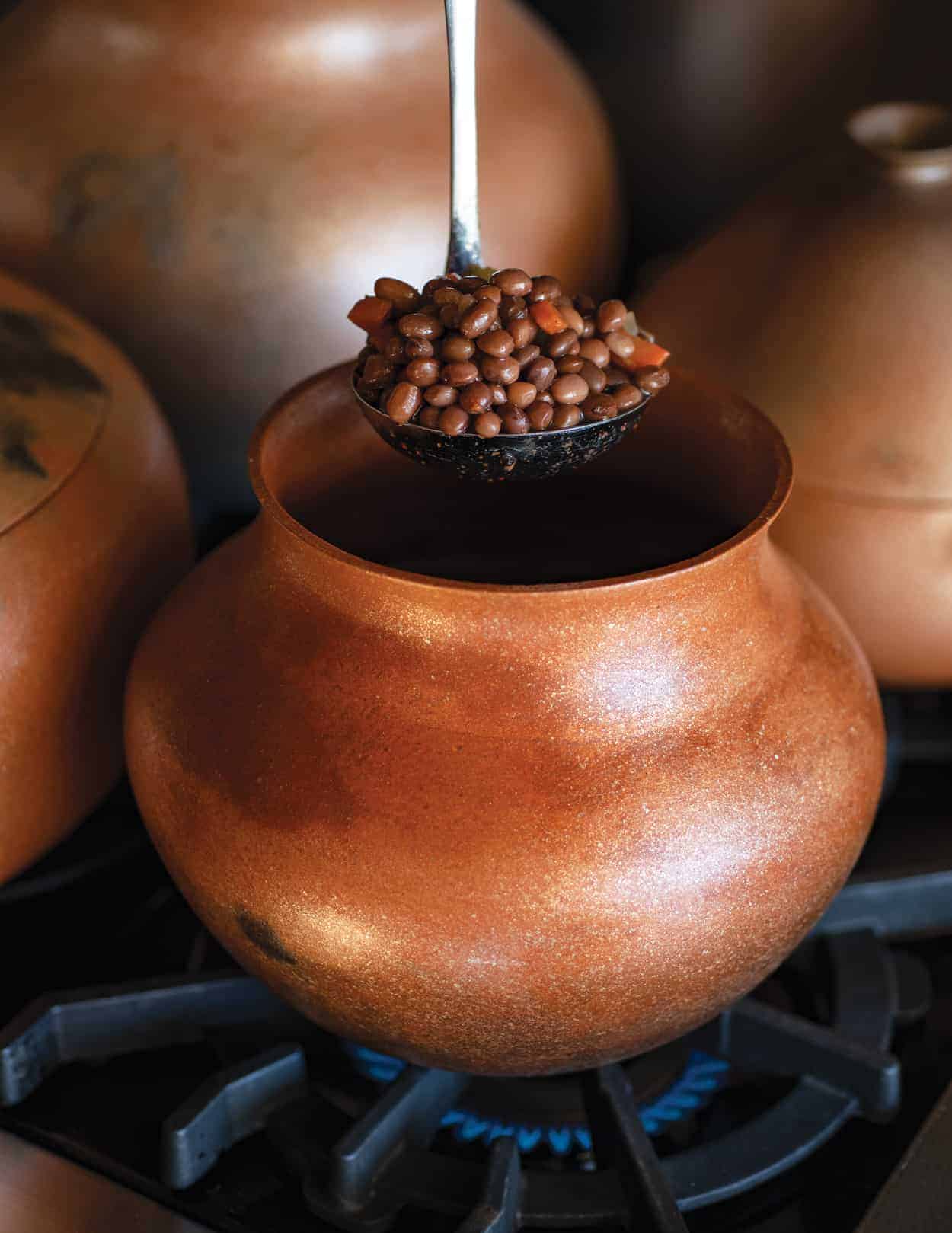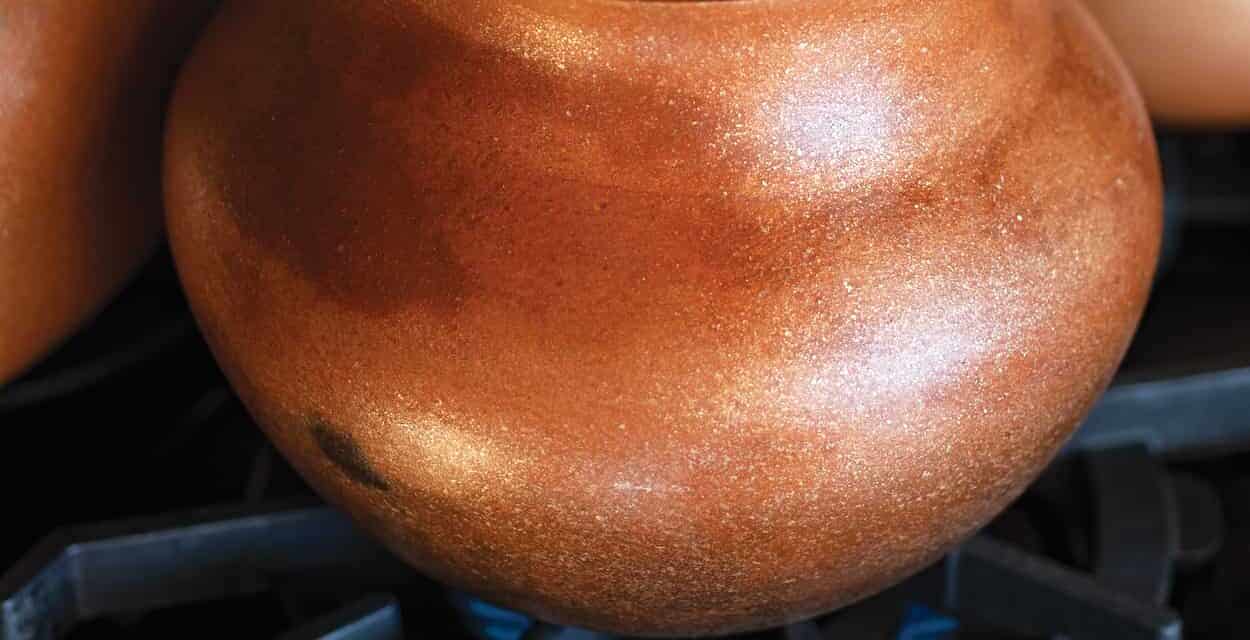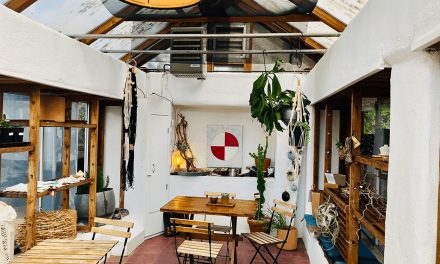Micaceous Pots of Northern New Mexico
By Marjory Sweet

Felipe Ortega micaceous pot. Photo by Douglas Merriam.
It’s just after 6pm but it feels like midnight in La Madera. It is completely dark outside, except for the stars and a few strings of holiday lights. It is dim inside Johnny Ortiz’s farmhouse, too. A selection of bowls and cooking pots are laid out, and at first glance, they appear as dark as the winter night. I pick up one bowl, shockingly thin and lightweight for a ceramic piece, and turn it toward the glow of the fire. “Even tap water tastes better in one of these,” I’ve been told. A glittery surface shines in the light. Tiny flecks of what appears to be gold and silver are scattered throughout the matte black exterior. The glitter comes from local mica and the ashen surface from smoke. The optical effect is magical; just a hint of the extraordinary story these pots hold.
Ortiz is the creator and chef of Shed, an ongoing dinner series based in La Madera that celebrates foraged and farmed ingredients native to northern New Mexico. The wild plums, honey mesquite, and heirloom white corn are not the only hand-crafted elements of the meal. “When I started Shed, I wanted to make my own ceramics,” Ortiz explains. Initially, this meant porcelain ware, which he learned how to create while living in California. When the dinners found a home in New Mexico, however, he wanted something that resonated with the place. “I’m from Taos Pueblo and we have a tradition of micaceous, pit-fired pottery, so it felt right.” Not only would it be economical for Ortiz to create his own plates and bowls from local materials, it would be an opportunity for him to honor this personally significant cultural practice.
Micaceous clay runs through all aspects of Ortiz’s life and work. His cooking pots are micaceous, as are all of his serving dishes. (If you’ve attended a Shed dinner, you’ve eaten on one.) He soaks film in a watery solution of the clay and uses it to photograph his cooking, his animals, and the natural world around him. In the hallway hang gauzy, pinkish window curtains that get their color from a micaceous dye. His brother, Brandon, also works in micaceous. Even the most unlikely elements of the micaceous practice find purpose in Ortiz’s world. He prepares us a cocktail: mezcal, tonic, and a native three-leaf sumac berry. Instead of ice cubes, frozen rocks of rose quartz chill the drink. “I sifted them out of the clay,” he says of the stones. We later taste the mezcal, Del Maguey Chichicapa, on its own, in a small micaceous sipping cup. It tastes exceptionally floral. I can’t tell if it’s the quality of the mezcal or the clay itself. “It does change flavor pretty considerably,” Ortiz says of the mica-rich pottery. Food has “more depth” and is “more dynamic,” he says. “Acidic things become sweeter,” he adds, which could account for the highly palatable drink.
The relationship between the clay and the food or beverage it contains is fundamental to understanding these special pots. It is what makes micaceous equally soulful and practical. “These are living, breathing things. If you pour liquid into it, you can see the water line from the outside,” says Sunshine Lawley, of Pasqual’s gallery in Santa Fe, where they feature micaceous pottery. “It’s not vitrified and it’s not glazed, so all of the flavors are literally traveling throughout the clay,” explains Yolanda Rawlings, who has been working in micaceous for more than ten years and currently teaches it at Santa Fe Community College.

Micaceous plate created and photographed by Johnny Ortiz.
Rawlings studied closely with Felipe Ortega, who is widely considered a master of the micaceous tradition. You can’t talk about the legacy of micaceous in New Mexico without mentioning Ortega, a Jicarilla Apache potter, who is widely credited for reviving and popularizing the tradition. When he was a kid, he told his mother he didn’t like the taste of beans. “You will like beans if you eat them from your grandmother’s pot,” she insisted. Unfortunately, this pot was the only one of its kind, and the last remaining village resident who knew how to make these valuable vessels was ninety years old and blind. Ortega went to her immediately, determined to learn the craft. His first five pots broke in the fire, but the sixth one survived.
This small success defined the trajectory of his life. Ortega devoted himself to the micaceous tradition and shared that knowledge with locals and the world. He became a kind of micaceous missionary. “He shipped five hundred pounds of clay to Switzerland for a workshop,” says Katherine Kagel, the owner of Pasqual’s and an early, enthusiastic champion of Ortega’s work. She still recalls the taste of her first meal cooked in micaceous. It was local lamb, stewed in one of Ortega’s own pots, and the experience was life-changing. Her kitchen is now fully stocked in micaceous, as is her gallery. Ortega, who passed away last year, was an artist and a teacher, but above all he was a cook. Eating and gathering were central to his teaching career and he was constantly hosting groups at his studio in La Madera. “It wouldn’t be out of place for him to feed one hundred people . . . enchiladas, beans, rice, posole,” recalls Rawlings. “Turkey baked in a huge micaceous pots, in the horno. My favorite were his handmade corn tortillas.” She says, “The reason I was most drawn to micaceous was for the community. And I’ve tried to keep up Felipe’s legacy of building community around micaceous.”
Evidence of micaceous clay pottery dates back to at least AD 1300 in New Mexico. Mica-rich deposits are commonly found in volcanic, high-elevation regions such as the northern Rio Grande area. The tradition is most closely associated with the Taos and Picuris pueblos, but it was also used by the Jicarilla Apaches and other Native communities. Though in recent decades it has gained recognition as an art object, and contemporary Native artists are now working in micaceous, it is still predominantly considered a utilitarian craft. Technically, all micaceous pots are cooking pots, so you could use that ten thousand dollar gallery piece for making beans.
Clay cooking is an ancient custom worldwide, but the mica-rich earth is uniquely well-suited to the task. Mica is extremely durable, conducts heat very evenly, and holds heat long after it’s been removed from the flame. It acts more like a little clay oven than a sauce pot. You can cook your beans or adovada over an open flame and then serve them at the table from the same, still-warm pot. For many home cooks in New Mexico, micaceous pots are synonymous with beloved, regional dishes. “Green chile stew, pinto beans,” says Rawlings. “Anything that relies on a slow cooking process.” Now, many pots even come with a lid that conveniently doubles as a tortilla warmer at the table. (Traditionally, the curve of the pot was designed to control liquid in a way that made a lid unnecessary.) They work just as well, though, for a Thai curry or Bolognese ragù. Ortiz hands me a shallow, heavy micaceous casserole that he likes for slow-roasting chickens. The micaceous bean pot, in the style of Felipe Ortega, remains the quintessential example: wide, open neck, curving into a rounded set of “shoulders,” then tapering to a base. Typically, they are a glittery burnt orange color with a few smoky marks, “fire clouds” as they are called. “It’s not that you can’t find micaceous other places,” Rawlings says, “but it’s prevalent here and it has a history.” She hands me a pot from her shelf, saying, “I mean, it’s literally from the Land of Enchantment!”

Yolanda Rawlings micaceous pottery. Photos by Stephanie Cameron.
Unlike a lot of traditional Pueblo pottery, micaceous pots are not decorated with painted designs. Even the most elaborate pieces find their beauty solely in form, smoke marks, and the texture and appearance of the mica-abundant clay. These utilitarian pieces become imprinted with the marks of life in a home kitchen. Oil stains, fire scorch, and the small chips along a paper thin edge all become part of each pot’s story.
Most modern kitchen tools are designed to be used, dirtied, and then thoroughly cleaned to look new again, but you couldn’t put a micaceous pot in the dishwasher even if you wanted to. Perhaps because they are so rigorously hand-made (the clay is hand harvested and the pots are hand built, never wheel thrown) and culturally symbolic, micaceous pots seem to inspire the kind of appreciation and intimacy one might feel toward a family heirloom. Rawlings seems to know each of her micaceous pieces intimately and points out that her chai pot, for example, “was originally my first bean pot.” She says, “I always say if you can afford it, you should have one for sweet and one for savory. Certain pots I gravitate to because I’ve had success cooking in them before. Do they have a memory? Some people believe they do. I’m not sure it can be proven . . . but it’s nice to think that way, right?”
Ortiz describes his micaceous process the same way a farmer might describe a season in the field. “In the spring, I dig the clay. In the winter, I process it and build as much as I can when I can’t farm or forage. I fire in the spring when it’s warm and the pit is dry.” There is a strong kinship between micaceous pottery and the natural world. Rawlings also resonates with the agricultural-like spirit of the work. “I really believe in all the ceremony around it because I have that connection to nature.” Her cycle of work echoes Ortiz’s. “We harvest clay in the warmer months, once the earth has thawed. We only take what we need, maybe one truck-bed’s load.” Then begins the laborious process of mixing, sifting, and kneading the clay. Each artist approaches these steps somewhat differently, but the end result is a pliable clay, free of impurities, tempered by some quantity of mica. “The clay is eighty percent clay and twenty percent mica, and the slip [a slurry of clay that takes the place of a glaze in micaceous work] is the reverse, eighty percent mica and twenty percent clay,” Rawlings explains. She begins each pot by patting out a flat even circle of clay, handling it like dough. “We start with a ‘tortilla,’” she says affectionately. She builds the pot from the base up with coils of clay that are stacked and then smoothed. “Whenever I’m coiling I give thanks to the four directions, the spirit of the clay, and whatever my intentions are on that particular day,” she says. “That’s my commitment to Felipe. He was very concerned that the craft was going to go away, because it almost did.” Traditionally, micaceous work is always pit-fired, but for consistency and ease, some artists choose to fire in a kiln. Different firing techniques produce a different appearance on the exterior. “You develop a relationship with Clay Mother. And that’s really what Felipe taught us. She was going to teach us about ourselves more than he ever could. And more than we ever could.”

Micaceous pottery created and photographed by Johnny Ortiz.
Micaceous pottery is always fired at a low temperature, so the clay remains porous and intermingles with its contents in a way that just isn’t possible in most cookware. It’s like the clay itself becomes another ingredient in whatever dish you’re preparing. “When you’re using metal to cook, the transfer of heat is rapid and it’s shocking to your food, whereas when you’re cooking with micaceous clay, it’s more of a slow, even heat. It lasts longer and it retains more flavor,” says Rawlings. Ask anyone who is familiar with micaceous cooking and the first thing they will tell you is that everything tastes better cooked in mica. The clay itself is alkaline and much of our food is acidic, so when the two combine, it’s possible that we experience a perfectly balanced flavor note. Another theory claims the alkalinity of the clay, mixed with the acidity of the mica itself, is what creates the enhanced flavor. Whatever the exact science may be, there is little doubt about its effect on food. “Many people believe that there is a sweeter taste from the clay. I just think it draws out flavor . . . and yes, the vessels are going to acquire a taste. Sometimes I will make cups without the slip, just so [the drink] can travel faster into the earthen clay,” Rawlings tells me. “Felipe used to have one pot just for beans and another for the tomato sauce—the clay really evened out the acidity.”
Then again, the flavor might simply be a byproduct of the emotional experience of eating from a micaceous pot. “It just makes sense,” says Rawlings. “Your food comes from this earth, you should eat it out of something that also comes from the earth. It completes that cycle.”













